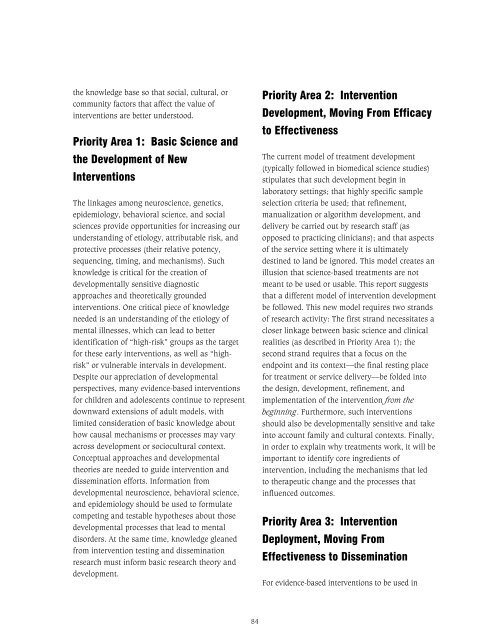Research on Child and Adolescent Mental Health
Research on Child and Adolescent Mental Health
Research on Child and Adolescent Mental Health
You also want an ePaper? Increase the reach of your titles
YUMPU automatically turns print PDFs into web optimized ePapers that Google loves.
the knowledge base so that social, cultural, or<br />
community factors that affect the value of<br />
interventi<strong>on</strong>s are better understood.<br />
Priority Area 1: Basic Science <strong>and</strong><br />
the Development of New<br />
Interventi<strong>on</strong>s<br />
The linkages am<strong>on</strong>g neuroscience, genetics,<br />
epidemiology, behavioral science, <strong>and</strong> social<br />
sciences provide opportunities for increasing our<br />
underst<strong>and</strong>ing of etiology, attributable risk, <strong>and</strong><br />
protective processes (their relative potency,<br />
sequencing, timing, <strong>and</strong> mechanisms). Such<br />
knowledge is critical for the creati<strong>on</strong> of<br />
developmentally sensitive diagnostic<br />
approaches <strong>and</strong> theoretically grounded<br />
interventi<strong>on</strong>s. One critical piece of knowledge<br />
needed is an underst<strong>and</strong>ing of the etiology of<br />
mental illnesses, which can lead to better<br />
identificati<strong>on</strong> of “high-risk” groups as the target<br />
for these early interventi<strong>on</strong>s, as well as “highrisk”<br />
or vulnerable intervals in development.<br />
Despite our appreciati<strong>on</strong> of developmental<br />
perspectives, many evidence-based interventi<strong>on</strong>s<br />
for children <strong>and</strong> adolescents c<strong>on</strong>tinue to represent<br />
downward extensi<strong>on</strong>s of adult models, with<br />
limited c<strong>on</strong>siderati<strong>on</strong> of basic knowledge about<br />
how causal mechanisms or processes may vary<br />
across development or sociocultural c<strong>on</strong>text.<br />
C<strong>on</strong>ceptual approaches <strong>and</strong> developmental<br />
theories are needed to guide interventi<strong>on</strong> <strong>and</strong><br />
disseminati<strong>on</strong> efforts. Informati<strong>on</strong> from<br />
developmental neuroscience, behavioral science,<br />
<strong>and</strong> epidemiology should be used to formulate<br />
competing <strong>and</strong> testable hypotheses about those<br />
developmental processes that lead to mental<br />
disorders. At the same time, knowledge gleaned<br />
from interventi<strong>on</strong> testing <strong>and</strong> disseminati<strong>on</strong><br />
research must inform basic research theory <strong>and</strong><br />
development.<br />
Priority Area 2: Interventi<strong>on</strong><br />
Development, Moving From Efficacy<br />
to Effectiveness<br />
The current model of treatment development<br />
(typically followed in biomedical science studies)<br />
stipulates that such development begin in<br />
laboratory settings; that highly specific sample<br />
selecti<strong>on</strong> criteria be used; that refinement,<br />
manualizati<strong>on</strong> or algorithm development, <strong>and</strong><br />
delivery be carried out by research staff (as<br />
opposed to practicing clinicians); <strong>and</strong> that aspects<br />
of the service setting where it is ultimately<br />
destined to l<strong>and</strong> be ignored. This model creates an<br />
illusi<strong>on</strong> that science-based treatments are not<br />
meant to be used or usable. This report suggests<br />
that a different model of interventi<strong>on</strong> development<br />
be followed. This new model requires two str<strong>and</strong>s<br />
of research activity: The first str<strong>and</strong> necessitates a<br />
closer linkage between basic science <strong>and</strong> clinical<br />
realities (as described in Priority Area 1); the<br />
sec<strong>on</strong>d str<strong>and</strong> requires that a focus <strong>on</strong> the<br />
endpoint <strong>and</strong> its c<strong>on</strong>text—the final resting place<br />
for treatment or service delivery—be folded into<br />
the design, development, refinement, <strong>and</strong><br />
implementati<strong>on</strong> of the interventi<strong>on</strong> from the<br />
beginning. Furthermore, such interventi<strong>on</strong>s<br />
should also be developmentally sensitive <strong>and</strong> take<br />
into account family <strong>and</strong> cultural c<strong>on</strong>texts. Finally,<br />
in order to explain why treatments work, it will be<br />
important to identify core ingredients of<br />
interventi<strong>on</strong>, including the mechanisms that led<br />
to therapeutic change <strong>and</strong> the processes that<br />
influenced outcomes.<br />
Priority Area 3: Interventi<strong>on</strong><br />
Deployment, Moving From<br />
Effectiveness to Disseminati<strong>on</strong><br />
For evidence-based interventi<strong>on</strong>s to be used in<br />
84

















